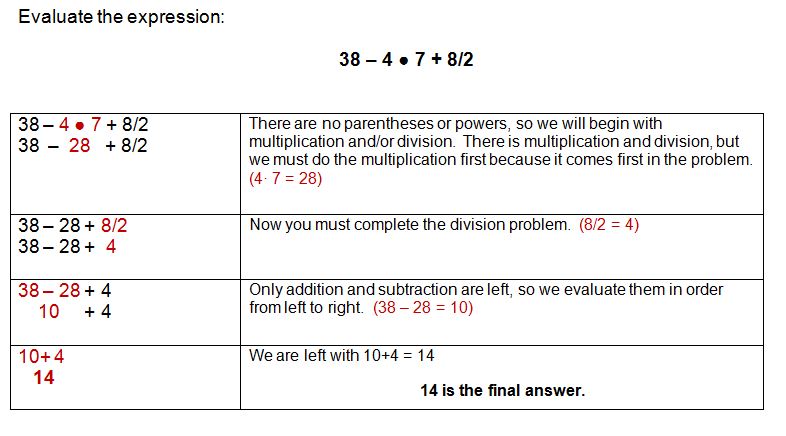 P is for parentheses, e is for exponent, m is for multiplication, d is for division, a is for addition, and s is for subtraction. Complete operations in this order." width="625" height="187" />
P is for parentheses, e is for exponent, m is for multiplication, d is for division, a is for addition, and s is for subtraction. Complete operations in this order." width="625" height="187" />How many times have you evaluated a numerical expression, and even though you know your addition, subtraction, multiplication, and division is correct, you still have the wrong answer?
If this has happened to you, then you probably haven't used the Order of Operations correctly.
The order of operations is a set of rules that you must follow in order to correctly evaluate a numerical expression that contains multiple operations (a combination of addition, subtraction, multiplication, and division).
In order to evaluate an expression with more than one operation, you must:
1. Evaluate expressions inside of grouping symbols (parenthesis or brackets).
2. Evaluate powers (think exponents).
3. Multiply and/or divide from left to right.
4. Add and/or subtract from left to right.
In order to remember this set of rules, many people remember the acronym, PEMDAS. Check it out:
 P is for parentheses, e is for exponent, m is for multiplication, d is for division, a is for addition, and s is for subtraction. Complete operations in this order." width="625" height="187" />
P is for parentheses, e is for exponent, m is for multiplication, d is for division, a is for addition, and s is for subtraction. Complete operations in this order." width="625" height="187" />
 34 minus 4 times 7 plus 8 divided by 2. The solution to this problem is 14." width="786" height="436" />
34 minus 4 times 7 plus 8 divided by 2. The solution to this problem is 14." width="786" height="436" />
If you find that you are having trouble, use colored pencils to help color code your work as I have done in the example above.
This will help you to organize your work and make sure that you follow the rules correctly.
Many people get confused because you may start computing in the middle of the numerical expression.
You can color code by underlining the part of the problem that you are focusing on. Take a look at Example 2.